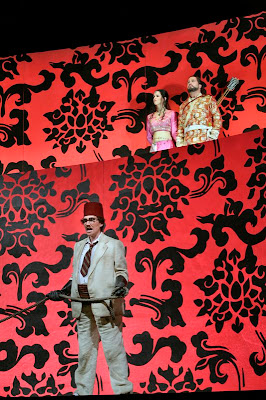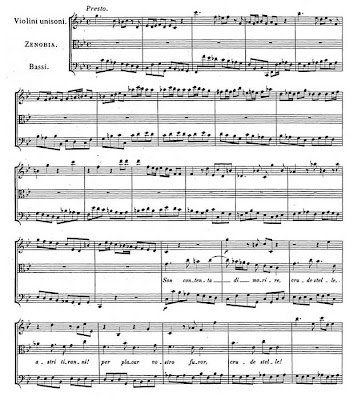For more background on this opera, see my preview article on Radamisto.
In the last 20 years, Handel's operas have undergone a Renaissance of interest. In the past year alone, we have reviewed two of them in stage productions (Alcina and Tamerlano), a couple complete recordings (Tolomeo and Floridante), and several recital discs. Radamisto is the fifth Handel opera staged at Santa Fe Opera, and the company turned to a notorious name in the Handel revival for its new production. American director David Alden has been upsetting traditionalist artists for years, especially in associations with Peter Jonas at English National Opera and in Munich; the latter company reprised all of Alden's Handel productions in 2006, as part of Jonas's farewell. Alden has directed at Santa Fe before, but this was the company's first attempt to import his sensational Handel staging.

(L to R) Laura Claycomb (Polissena), Heidi Stober (Tigrane), Kevin Murphy (Farasmane), Luca Pisaroni (Tiridate),
David Daniels (Radamisto), and Deborah Domanski (Zenobia) in Radamisto, Santa Fe Opera, 2008 (Photo © Ken Howard)
The results, predictable enough, are mixed: people sat up and paid attention, if only to wonder why the hell a leopard pierced with arrows was being suspended from the ceiling mid-aria; many of those same people were left wondering what most of the stage business had to do with Handel's story. With this kind of postmodern production, a traditionalist is likely to be irked, whether the outrages imposed on the libretto have any connection to the story or not. Unlike some directors, who seem to direct an opera without having read the libretto thoroughly, Alden's choices are generally based on careful thought. That does not necessarily mean that the staging will make sense.
Alden's staging turns on the character of Tiridate, presented as a sadist who relishes the domination and humiliation of his wife, Polissena. Costumed in colorful robes and forbidding armor and weaponry (costumes by Gideon Davey), he is the unhinged alpha dog, practically foaming at the mouth. His fetishization of violence is expressed in the animal symbols of ferocity that decorate the stage (sets also by Davey): croaking ravens perched on the walls and just inside the theater, the beastial masks of Tiridate's soldiers, the sculpted elephant lying on its side under a growling bear, a silver dragon with fiery mouth, even that sensational pincushioned leopard (which almost certainly was inspired by a very similar installation piece, with tigers instead of a leopard, in Cai Guo-Qiang's retrospective at the Guggenheim this winter). Even the peacocks in Tiridate's garden make sense, as the ultimate symbol of macho rodomontade.

Heidi Stober (Tigrane) with, above, Deborah Domanski (Zenobia) and David Daniels (Radamisto) in Radamisto, Santa Fe Opera, 2008 (Photo © Ken Howard) |
The leopard may simply be drawn from the same kind of eastern sources from which Alden drew his imagery, illustrations in Persian and Mughal manuscripts. The leopard also resonates with Ashurbanipal hunting lions or similar works in Assyrian art. The imagery helps reinforce the ruthlessness of Tiridate, which in turn explains the foil to this image of Middle Eastern savagery: his ally Tigrane, who is costumed, rather ridiculously, in grimy white suit, wide necktie, fez, fake paunch, and sandals. In other words, he is a dead ringer for Sidney Greenstreet's Signor Ferrari in Casablanca (and, by way of satirical tribute, Groucho Marx in A Night in Casablanca). Alden's productions are often political, and the fez, of Ottoman associations, was worn by native soldiers who fought for colonial armies and generally a hated symbol of European domination. Tigrane, at first Tiridate's helper, eventually becomes the instrument of his humiliation. It's hardly new, but the staging appears to be a postcolonial critique.
The libretto by Nicola Francesco Haym was itself the result of a shift of location from the original story. As told by Tacitus in Book 12 of the Annals, Pharasmanes and Radamistus were king and prince of Caucasian Iberia (Iveria), a kingdom in what is now Georgia, involved inextricably in warfare with what is now Armenia (notably against Mithridates). Through the intermediary sources, Handel's story was resituated to Armenia and Thrace, a shift that Alden's staging has corrected. Alden also demonstrated a willingness to make his staging and the music work together, as the most outrageous embellishments came from the singers in reaction to onstage action. The superb program notes, by Handel scholar Terence Best (editor of the Hallische Händel-Ausgabe), quote the characterization of Radamisto by Winton Dean, as an arch-serious opera seria with "no place for ironical light and shade." Be that as it may, Alden even found occasion to introduce some humor, as when Polissena has herself dumped before Tiridate in a rug, just like Zenobia -- anything to arouse her husband's interest.

Handel, "Son contenta di morire," from Radamisto |
In general, Handel's score sounded beautiful and lavishly decorated with embellishments. The only singer who could be considered a Baroque specialist, countertenor David Daniels, showed why he has made a career largely out of navigating the composer's vocal roulades. We just reviewed him in Washington's Tamerlano, and here as there he was a sure dramatic presence. The agility of his technique makes up for a slight shrillness at the top and a tendency to get covered at the bottom. His "Perfido, di a quell'empio tiranno" had some thrilling ornamentation, and the arching, drawn-out lines of "Ombra cara" were matched by the exquisite sotto voce rippling of the strings. The audience needed some education in the expectations of Baroque opera, however: as in several other places, applause before the return of the A section destroyed the moment. Laura Claycomb was the best of the female cast (see Scott Cantrell's feature article on her), a deranged Pollyanna version of Polissena, who suffered all of Tiridate's humiliations and often danced like a lunatic through her ritornelli. Her entrance with the cavatina "Sommi Dei" was smooth and luxurious, and the interpolated high notes and other embellishments of "Barbaro, partirò" were breath-taking.
Luca Pisaroni was an unhinged and vocally robust Tiridate, and the role does sit much better in the bass voice than in the tenor of the 1720 version. He overpowered Kevin Murphy's affecting Farasmane (he was a Santa Fe apprentice in 2006 and 2007), cast as a bearded, white-haired old man who spent most of the evening being dragged about in bonds. As the mysterious Tigrane, mezzo-soprano Heidi Stober had a slight nervous tendency to rush ahead of the orchestra, but produced a bold and generally beautiful sound. Former Santa Fe Opera apprentice Deborah Domanski replaced Christine Rice in the role of Zenobia in the final week before the production opened, and it is impressive that she could memorize all of the recitatives in that time, as this is surely not a role that any singer has ready. Domanski has a pretty sound, with a radiant upper range, and few sopranos would look that good in her midriff-baring costumes à la Barbara Eden in I Dream of Jeannie. Unfortunately, she was at sea in some of her more challenging arias, not able to keep up with the brash, jagged tempo of the blockbuster "Son contenta di morire," for example.
Other Reviews:
George Loomis, Radamisto, Santa Fe Opera (Financial Times, August 5)
Anthony Tommasini, From Handel, Faithlessness and Devotion (New York Times, August 4)
Anne Midgette, Promising 'Adriana' Could Use a Drama Lesson (Washington Post, August 4)
Scott Cantrell, 'Radamisto' voices, visuals dazzle (Dallas Morning News, August 3)
D. S. Crafts, Superb Arias in 'Radamisto' (Albuquerque Journal, July 22)
Craig Smith, A complex, vibrant 'Radamisto' (Santa Fe New Mexican, July 20) |
Harry Bicket did an excellent job of whipping a group of non-specialist musicians into shape, twenty-odd players drawn mostly from the regular Santa Fe Opera orchestra. It was a broad, edgy sound, with strong wind and brass contributions, all played on modern instruments. For example, the oboe solos in Zenobia's cavatina "Quando mai, spietata sorte" were plaintive and lush, and the trumpet solo and timpani gave an impressively martial sound to the war Sinfonia of the first act. The continuo consisted of two players from the cello section, augmented by specialists on two harpsichords, theorbo, and Baroque guitar (the latter's percussive sounds in "Son contenta di morire" were a highlight); there were also some special instruments in the percussion section.
Bicket had the appropriate volume of the best edition currently available, the Hallische Händel-Ausgabe, on the podium, although with some changes inserted on individual printouts. This was mostly the second 1720 and 1721 version of the opera, as edited by Michael Pacholke, seen by the editors of the HHA as "the best and most artistically satisfying." All of the dance music was cut from the score, except the gorgeous Passacaille, which served as introduction to the second half. With a few quibbles aside, this excellent Handel is one of the highlights of the Santa Fe Opera season, a chance to experience a taste of what Handel in Munich has been like in the past decade.
Handel's Radamisto will be repeated on August 1, 7, 15, and 20 at Santa Fe Opera.
























































2 comments:
I disagree with the conclusions you've reached. I saw the performance on Friday evening last and while the singing was quite fine, the sets and over all direction were ridiculous. I am hardly a traditionalist, but I do believe there is a narrative that must be served, even in experimental work. The actors seemed to have been given two directions: throw yourself against the wall OR throw yourself on the floor -- the only exception was waiting for someone else to throw you to the wall or the floor. As for the sets, the only service they provided was to the narrative of an SFO photo book in 25 years and to press images like the one you've shown. They were glamorous without interest. Costumes were just so-so between the soprano writing on the floor and showing her pilates abs and the curious choice of a suit for Tigrane while dressing everyone else more or less in something from a National Geographic picture book. Again, the singing was fine. Everything else, was just a vain attempt at something like "drama."
The sets were exquisite as well as the choreography, singing, music and constumes. The whole experience was quite impressive, both modern and true to the artistic intention of Handel.
Post a Comment